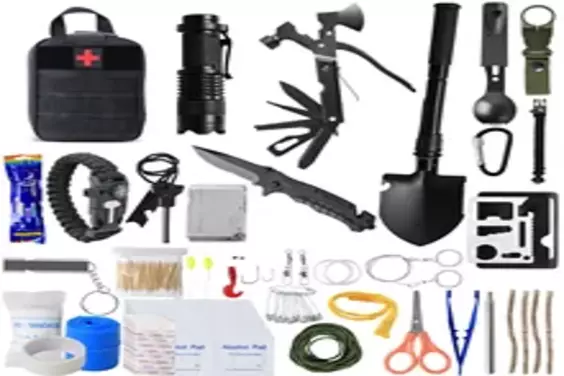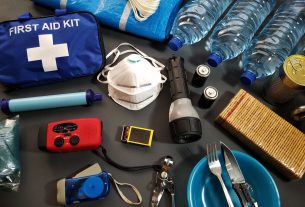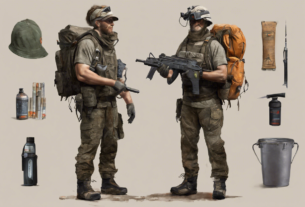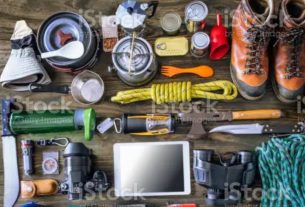Introduction
In our ever-changing world, the importance of preparedness cannot be overstated. Emergencies and unexpected situations can strike at any moment, and having the right tools and supplies can mean the difference between safety and peril. This comprehensive guide aims to explore the world of survival kits and their uses in great detail. Whether you’re a seasoned survivalist or a novice looking to enhance your emergency preparedness, this article will provide you with a thorough understanding of survival kits and how to use them effectively.
I. Understanding Survival Kits
A survival kit is a carefully curated collection of essential tools, supplies, and resources designed to help individuals or groups endure and survive in challenging or emergency situations. These kits are meticulously crafted to address a wide range of scenarios, from natural disasters like hurricanes and earthquakes to wilderness adventures and everyday emergencies.
Why Do You Need a Survival Kit?
Emergencies and unforeseen circumstances can occur unexpectedly. Consider these situations:
- A hiker lost in the wilderness.
- A family trapped at home during a severe storm with no power.
- A car breaking down in a remote area.
- An unexpected evacuation due to wildfires.
In all these scenarios, a well-equipped survival kit can be a lifeline, providing essential items that can make a crucial difference in ensuring your safety and well-being.
II. Types of Survival Kits
Survival kits come in various types, each tailored to specific situations. Here are some of the most common types:
1. Wilderness Survival Kit:
This kit is designed for outdoor enthusiasts and adventurers who venture into the wild. It contains items like fire-starting tools, navigation aids, shelter materials, and emergency signaling devices.
Components of a Wilderness Survival Kit:
- Firestarter (waterproof matches, lighters, fire starter rods).
- Compass and map.
- Compact tent or tarp.
- Emergency whistle and signal mirror.
- Water purification tablets or filters.
- Compact first aid kit.
2. Emergency Home Kit:
An emergency home kit is geared towards preparing for natural disasters or unexpected events in and around your home. It includes items such as non-perishable food, water, first aid supplies, flashlights, and batteries.
Components of an Emergency Home Kit:
- Non-perishable food (canned goods, dry goods, freeze-dried meals).
- Sufficient water for at least three days.
- First aid supplies (bandages, antiseptic wipes, pain relievers).
- Flashlights and batteries.
- Battery-powered or hand-crank radio.
- Warm clothing and blankets.
- Essential documents (identification, insurance policies, medical records).
3. Car Survival Kit:
A car survival kit is aimed at addressing vehicle breakdowns or accidents in remote areas. It contains items like jumper cables, a tire repair kit, first aid supplies, and tools.
Components of a Car Survival Kit:
- Jumper cables.
- Basic automotive tools (screwdrivers, pliers, wrenches).
- Tire repair kit and pressure gauge.
- Flashlight and batteries.
- Reflective vest and warning triangles.
- Non-perishable snacks and water.
- First aid kit.
4. Bug-Out Bag:
A bug-out bag is designed for rapid evacuation during emergencies like wildfires, floods, or civil unrest. It typically includes food, water, clothing, shelter, and important documents.
Components of a Bug-Out Bag:
- Non-perishable food (energy bars, canned food).
- Water purification methods (filters or tablets).
- Compact shelter (tent or tarp).
- Clothing suitable for the climate.
- Fire-starting tools (lighters, waterproof matches).
- Personal documents (identification, passports, financial information).
- Multi-tool or knife.
- First aid supplies.
5. Everyday Carry Kit (EDC):
An everyday carry kit, or EDC, is meant for daily use and addressing common challenges. It includes items like a multi-tool, flashlight, pocketknife, and a first aid kit.
Components of an EDC Kit:
- Multi-tool with various functions (pliers, knife, screwdriver).
- Small flashlight with extra batteries.
- Pocketknife.
- Mini first aid kit (bandages, antiseptic wipes, pain relievers).
- Whistle or personal alarm.
III. Essential Components of a Survival Kit
Regardless of the type of survival kit, several core components are vital for addressing a wide range of situations:
1. Water and Water Purification:
Clean water is essential for survival. Most kits include water purification tablets, filters, or compact water purifiers.
Water and Water Purification Supplies:
- Water bottles or hydration reservoirs.
- Water purification tablets.
- Water filter or purifier.
2. Food and Nutrition:
Non-perishable, high-calorie food items like energy bars or MREs (Meals Ready to Eat) are commonly included.
Food and Nutrition Supplies:
- Non-perishable food (canned goods, granola bars, dried fruits).
- Energy-rich snacks.
- MREs or freeze-dried meals.
3. Shelter and Warmth:
Items such as a compact tent, space blanket, or emergency bivvy sack provide protection from the elements.
Shelter and Warmth Supplies:
- Compact tent or tarp.
- Emergency space blanket.
- Warm clothing (hat, gloves, extra layers).
- Hand warmers.
4. Fire-Starting Tools:
Fire is crucial for warmth, cooking, and signaling for help. Kits often contain waterproof matches, lighters, and fire starters.
Fire-Starting Supplies:
- Waterproof matches.
- Lighters.
- Fire starter rods or blocks.
- Tinder (cotton balls soaked in petroleum jelly).
5. First Aid Supplies:
Basic medical supplies, including bandages, antiseptic wipes, pain relievers, and medical tape, are essential for treating injuries.
First Aid Supplies:
- Adhesive bandages (various sizes).
- Antiseptic wipes or solution.
- Pain relievers (ibuprofen or acetaminophen).
- Medical tape and scissors.
- Tweezers and needle for splinter removal.
6. Navigation and Signaling:
A map, compass, or GPS device helps with navigation, while signaling tools like a whistle or signal mirror aid in rescue efforts.
Navigation and Signaling Supplies:
- Compass and map.
- GPS device or smartphone with GPS functionality.
- Emergency whistle.
- Signal mirror.
- Glow sticks or flares.
7. Multi-Tool or Knife:
A versatile tool can assist with various tasks, from cutting to repair work.
Multi-Tool or Knife:
- Multi-tool with pliers, knife, screwdriver, and other functions.
- Folding knife or pocketknife.
8. Lighting:
Flashlights, headlamps, or glow sticks provide illumination in low-light situations.
Lighting Supplies:
- Flashlight with extra batteries.
- Headlamp with adjustable brightness.
- Glow sticks or chemical light sticks.
9. Communication:
A portable radio or satellite phone can be vital for staying informed and calling for help.
Communication Supplies:
- Battery-powered or hand-crank emergency radio.
- Portable satellite phone with extra battery.
10. Personal Documents:
Copies of important documents like identification, passports, and insurance policies should be included.
Personal Documents:
- Copies of identification (passport, driver’s license).
- Copies of insurance policies (health, home, auto).
- Emergency contact information.
IV. How to Use a Survival Kit Effectively
Having a well-equipped survival kit is only part of the equation. Knowing how to use it effectively is equally crucial. Here are some tips:
1. Familiarize Yourself:
Become familiar with the contents of your kit. Know what each item is for and how to use it. Familiarization can make a significant difference in high-stress situations.
2. Regularly Check and Replace:
Check your kit regularly to ensure that items have not expired or become damaged. Replace any expired supplies promptly. Set reminders to conduct routine inspections.
3. Customize for Your Needs:
Tailor your kit to your specific needs and geographic location. Consider the climate, terrain, and potential hazards in your area. Customize items like clothing and shelter to match the environment.
4. Learn Basic Survival Skills:
Having the best survival kit is essential, but knowing how to apply basic survival skills is equally important. Skills like fire-making, first aid, and navigation can be invaluable. Consider taking survival courses or reading books on wilderness survival.
5. Practice Makes Perfect:
Practice using your survival kit in controlled environments to build confidence and competence. Set up your tent or shelter, start a fire, and purify water using the supplies in your kit. Practicing these skills can be fun and educational for the whole family.
6. Stay Calm and Prioritize:
In an emergency, staying calm and prioritizing your actions are critical. Remember the rule of threes: You can survive approximately three minutes without air, three hours without shelter in harsh conditions, three days without water, and three weeks without food. Focus on immediate needs like shelter, water, and signaling for help.
7. Signal for Rescue:
If you’re lost or need assistance, use signaling devices like whistles, mirrors, or brightly colored clothing to attract attention. Make use of any communication devices in your kit to call for help.
8. Preserve Resources:
Ration food, water, and other supplies to make them last as long as possible. Be mindful of your energy expenditure and stay hydrated.
V. Frequently Asked Questions (FAQs)
Q1. Can I buy a pre-made survival kit, or should I build one myself?
A1. Both options are viable. Pre-made kits are convenient and can be a good starting point, but building a custom kit allows you to tailor it to your specific needs and preferences.
Q2. How long do the supplies in a survival kit typically last?
A2. The shelf life of supplies varies, but it’s essential to check and replace expired items regularly. Most kits aim for a minimum of a 72-hour supply, but some can provide for longer durations.
Q3. Are survival kits only for extreme scenarios, or can they be useful in everyday situations?
A3. Survival kits are designed for a wide range of scenarios, from wilderness emergencies to everyday challenges like car breakdowns or power outages. Having a basic kit in your home or car can prove invaluable in unexpected situations.
Q4. Are there any legal restrictions on carrying survival kits or specific items in them?
A4. It’s essential to be aware of local laws and regulations regarding the carry of specific items, especially if you’re planning to travel internationally. Some items, like certain knives or firearms, may be subject to specific regulations.
Conclusion
A well-prepared survival kit is more than just a collection of items; it’s a lifeline in times of crisis. Whether you’re braving the wilderness, ensuring your family’s safety during emergencies, or simply seeking peace of mind in an unpredictable world, having the best survival kit at your disposal is a wise and responsible choice.
Remember that the effectiveness of your kit depends not only on its contents but also on your knowledge of how to use it. By staying informed, practicing essential survival skills, and regularly maintaining your kit, you’re taking proactive steps towards safeguarding yourself and your loved ones in the face of adversity.
In today’s uncertain world, being prepared is a virtue, and a well-prepared survival kit is your steadfast companion on the journey to safety and resilience.




